The design of the toilet flush tank: how does the flush structure work and what does it consist of?
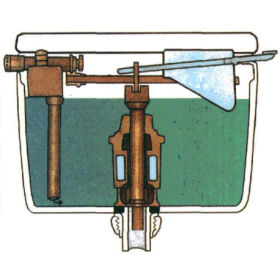
It is impossible to imagine comfortable housing without a well-maintained toilet room, the central place in which is occupied by a toilet. A significant part of this subject familiar to us is the drain tank. It seems to be an absolutely unsightly container, which, by the way, is not always visible - sometimes it is mounted on the wall. However, as soon as the drain mechanism for the toilet becomes unusable, we immediately understand the importance of this item - a real catastrophe sets in.
Content
The principle of mechanical flushing
A toilet without a well-thought-out flush system would functionally turn into a regular pot (or a night vase), which sooner or later would have to be emptied. Flushing with tap water frees us from unnecessary actions and makes the procedure of visiting the toilet quite comfortable.
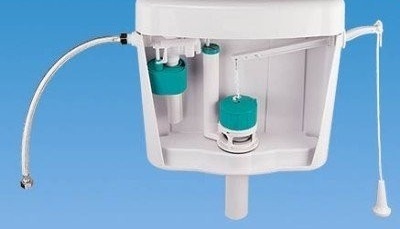
One of the outdated models of the drain tank perfectly demonstrates the principle of operation: pressure on the lever - water drain - automatic opening of the filling valve - water intake - closing the valve
Water from the pipes through a flexible hose enters the drain tank, which is equipped with two mechanisms - bulk and drain. The filling equipment allows water to accumulate in the tank, but only to a certain level, then the supply valve closes.
The drain valve begins to function when we press the button (pull the chain or lever). A predetermined portion of water is poured at a high speed into the toilet bowl, flushing all its contents into the sewer. As you can see, the principle of operation of the drain tank is simple and is based on the alternate action of the shutoff valves.
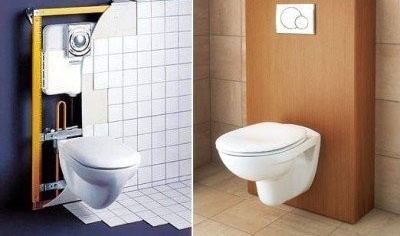
It is not surprising that young children cannot answer the question: what is a drain tank? They do not even suspect that this device is hiding behind a wall above the toilet
So, we will try to understand the design that is inside the tank - it just refers to those things that we absolutely do not pay attention to in everyday life.
The components of the drain tank
Knowing well the design of the toilet flush cistern, you can quickly repair it or, at least, independently acquire failed parts.
You can read more about tank repair in our article:https://aquatech.tomathouse.com/en/santehnika/unitaz-rakovina/remont-slivnogo-bachka-unitaza.html
Filling valve
Its purpose is to regulate the water level in the tank and, as it decreases, supply the necessary quantity. Once upon a time they came up with an elementary indicator of the water level - a float, and it turned out to be such a successful invention that it is still an indispensable part of the fittings.
The initial device looked as follows: a brass beam, at one end having a float, at the other - a valve with a rubber gasket, blocking the water. The modern design has slightly changed, but the principle of operation has remained the same. On the drain scheme toilet bowl the interaction of all parts of the mechanism is clearly visible.
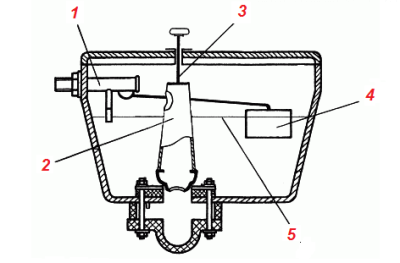
Details of the design of the drain tank: 1 - bulk valve; 2 - a pear in a single block with overflow; 3 - handle (thrust); 4 - a float; 5 - water level
The float began to move vertically, and not settle down horizontally, as before. Water began to flow into the tank faster, since the hole was completely open, and the shut-off valve did not block it gradually, but in its entirety, but at the very end of the set. Another difference - the valve is located in the lower part, and not in the side.
Drain and overflow system
All the latest modifications came from one initial option - a system with a pear. The more “ancient” design of the toilet flush cistern was equipped with a soft rubber bulb that sealed the drain hole. It was worth pulling the lever - and the water rushed down with a noise.
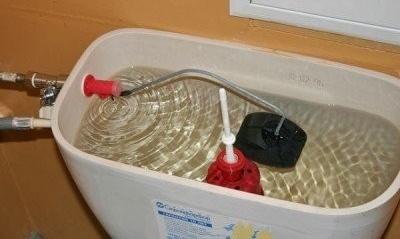
An example of an elementary device of a toilet flush tank, where the filling mechanism is equipped with a plastic float on the beam and the drain system with a traditional rubber bulb
Now the drain device looks different. This is a reinforcing unit associated with a loading and overflow system. It starts to function after pressing the button located in the lid. Widespread concern about saving water has led to another innovation - the button consists of two parts; choosing one of them, you can provide a small or large drain.
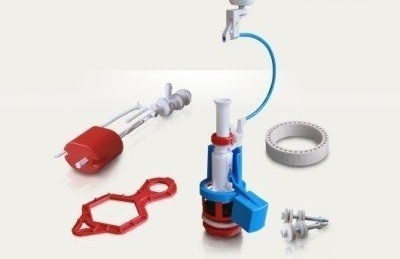
The fittings for the drain tank consist of plastic parts and rubber gaskets. In the event of a breakdown, you can purchase the entire kit or one of the parts separately in the plumbing store
The drain mechanism is combined with overflow - insurance against overflow of the tank. If there is an excess of water, then it does not spill out, but goes directly to the sewer. According to experts, German drain fittings are of better quality, for lack of it - Polish, which, in addition, costs much less.
You may also find useful material on installing stop valves:https://aquatech.tomathouse.com/en/santehnika/armatura/armatura-slivnogo-bachka-unitaza.html.
Classification of toilet bowls
There are several divisions into groups, and in one of them the classification is based on the features of the mechanism of the toilet flush cistern.
So, there can be two locations of a button or lever:
- Lateral. It is most often used for tanks that are not mounted on the toilet shelf, but on the wall - at a certain height. With this device, the water is drained, pulling the chain.
- Top. A button that activates the drain system is installed exactly in the middle of the tank cap.

The button for draining the tank installed in the wall exists separately from it and is mounted directly above the toilet, being an example of a modern aesthetic approach
According to the material of manufacture:
- Cast iron. Until now, pig iron in our country is considered something very practical, so many people keep their rare treasures and do not want to change them to modern ones - more convenient and beautiful.
- Earthenware. The most popular, as they are part of the toilet compact. Familiar models that are easily mounted on the toilet shelf have many designs that differ in shape and color.
- Plastic Tanks that are built into the wall and therefore have a not quite ordinary, more flat shape.
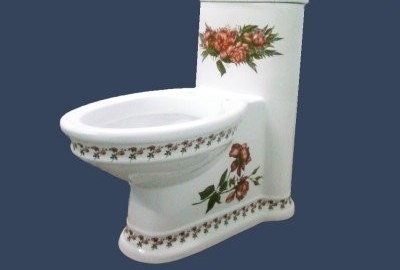
Among the simple economical sanitary ware, you can find real masterpieces made in a variety of styles - from country to modern.
By installation method:
- Top mount. The tank is mounted high on the wall, exactly above the toilet, and communicates with the toilet through a pipe. This method of fastening is outdated, however, there are several models of such a plan on sale, since the demand for them does not stop.
- Wall mounting.The modern way, requiring a complete alteration of at least one wall, because the tank will be hidden inside it. It seems that there is more space in the toilet, although the erected wall "steals" some part of the area.
- Tank on the toilet shelf. The most common, familiar to all model. The good thing is that in the event of a breakdown, any malfunction can be quickly repaired.

Toilets with a tank suspended high above the ceiling are not suitable for every interior, but will look great in a retro-style toilet room
In our next article, you will learn about the causes of condensation on the tank and how to eliminate them:https://aquatech.tomathouse.com/en/santehnika/unitaz-rakovina/poteet-bachok-unitaza.html.
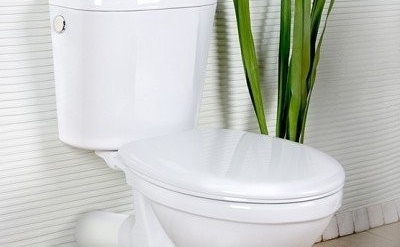
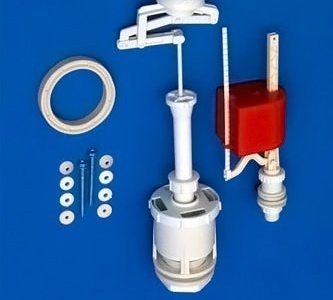
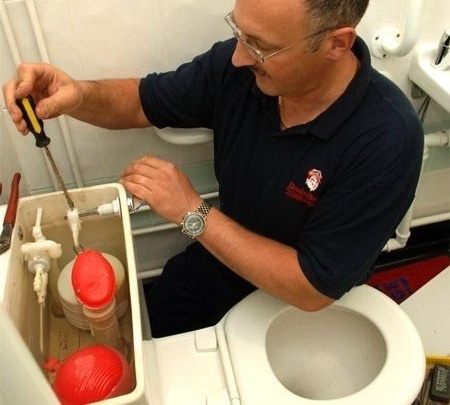
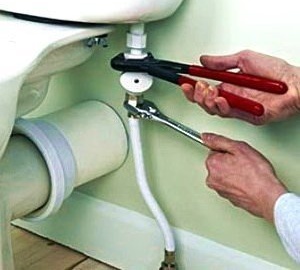
2 comments